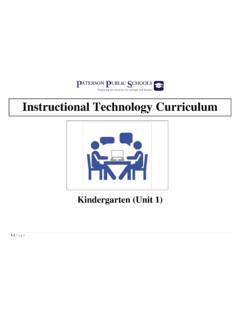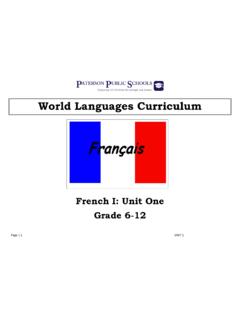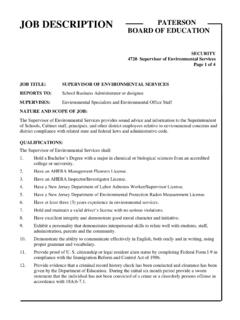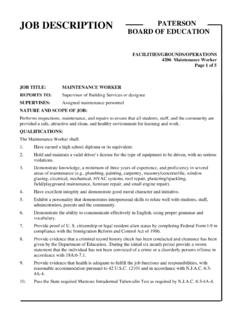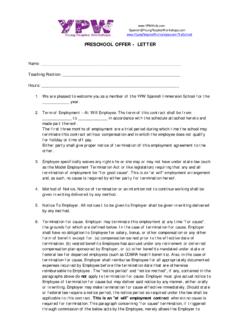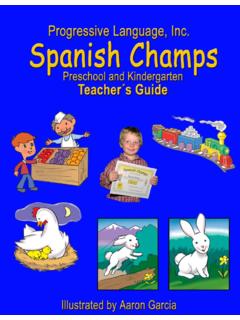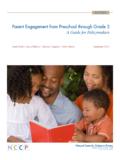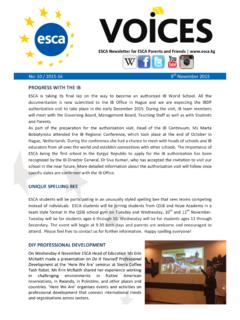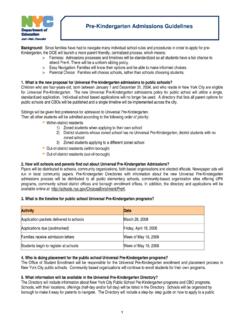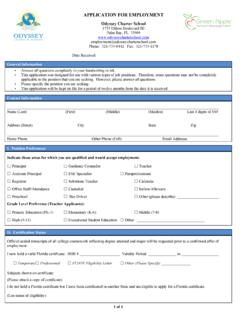Transcription of The Creative Curriculum System for Preschool …
1 1 The Creative Curriculum System for PreschoolThe Creative Curriculum System for PreschoolScope and sequence for 3-Year-OldsThis document shows the scope of the concepts and skills in the The Creative Curriculum System for Preschool and the sequence in which they are introduced. When you use the complete System , including the Teaching Guides, Intentional Teaching Cards , Mighty Minutes , and Book Discussion Cards , you can be sure that these concepts and skills are introduced and reinforced in a logical, thoughtful, sequential, and coherent order. Each child and each classroom is unique. Use this chart as a starting point for most children in your class and then make adjustments according to the individual strengths and needs identified by your assessment findings.
2 If you are creating your own studies rather than using the Teaching Guides, this chart will help you plan experiences thoughtfully and intentionally on the basis of each child s current levels of development and Emotional, Physical, Language, Cognitive, Literacy, and MathematicsArea of Development & LearningObjectiveBeginning of the YearMiddle of the YearEnd of the YearSocial EmotionalSelf-regulationBegins to comfort self by seeking out special object or personBegins to accept redirection from adults Begins to demonstrate confidence in meeting own needsComforts self by seeking out special object or personAccepts redirection from adults Begins to look at a situation differently or delay gratificationBegins to manage classroom rules, routines.
3 And transitions with occasional remindersDemonstrates confidence in meeting own needsIs able to look at a situation differently or delay gratificationManages classroom rules, routines, and transitions with occasional remindersBegins to take responsibility for own well-being2 The Creative Curriculum System for PreschoolScope and sequence for 3-Year-OldsArea of Development & LearningObjectiveBeginning of the YearMiddle of the YearEnd of the YearSocial Emotional, continuedPositive relationshipsManages separations without distress and engages with trusted adultsBegins to demonstrate concern about the feelings of othersBegins to use successful strategies for entering groupsBegins to play with one or two preferred playmatesManages separations without distress and engages with trusted adultsDemonstrates concern about the feelings of othersBegins to use successful strategies for entering a groupPlays with one or two preferred playmates Begins to engage with trusted adults as resources and to share mutual interestsBegins to identify basic emotional reactions of
4 Others and their causes accuratelyUses successful strategies for entering a groupBegins to establish a special friendship with one other child, but the friendship might only last a short whileGroup participationBegins to take turns Seeks adult help to resolve social problemsBegins to take turns Begins to suggest solutions to social problemsTakes turns Suggests solutions to social problems PhysicalTraveling skillsBegins to move purposefully from place to place with controlBegins to move purposefully from place to place with controlMoves purposefully from place to place with controlBalancing skillsBegins to sustain balance during simple movement experiencesSustains balance during simple movement experiencesBegins to sustain balance during
5 Complex movement experiencesGross-motor manipulative skillsBegins to manipulate balls or similar objects with flexible body movementsBegins to manipulate balls or similar objects with flexible body movementsManipulates balls or similar objects with flexible body movementsFine-motor skillsBegins to use refined wrist and finger movements Begins to grip drawing and writing tools with whole hand but may use whole-arm movements to make marksUses refined wrist and finger movements Grips drawing and writing tools with whole hand but may use whole-arm movements to make marksBegins to hold drawing and writing tools by using a three-point finger grip but may hold the instrument too closely to one endBegins to use small, precise finger and hand movementsHolds drawing and writing tools by using a three-point finger grip but may hold the instrument too closely to one end3 The Creative Curriculum System for PreschoolScope and sequence for 3-Year-OldsArea of Development & LearningObjectiveBeginning of the YearMiddle of the YearEnd of the YearLanguageListening to and understanding languageBegins to respond appropriately to specific vocabulary and simple statements, questions.
6 And storiesFollows simple requests not accompanied by gesturesBegins to respond appropriately to specific vocabulary and simple statements, questions, and storiesFollows directions of two or more steps that relate to familiar objects and experiencesResponds appropriately to specific vocabulary and simple statements, questions, and storiesBegins to follow detailed, instructional, multistep directionsExpressive languageBegins to describe and tell the use of many familiar items Begins to be understood by most people; may mispronounce new, long, or unusual wordsBegins to use three- to four-word sentences; may omit some words or use some words incorrectlyBegins to tell simple stories about objects, events, and people not present; lacks many details and a conventional beginning, middle, and endBegins to describe and tell the use of many familiar items Begins to be understood by most people; may mispronounce new, long, or unusual wordsUses three- to four-word sentences; may omit some words or use some words incorrectly Begins to tell stories about other times and places that have a logical order and that include major detailsDescribes and tells the use of many familiar items Is understood by most people.
7 May mispronounce new, long, or unusual wordsUses complete, four- to six-word sentencesBegins to incorporate new, less- familiar, or technical words in everyday conversationsTells stories about other times and places that have a logical order and that include major detailsConversational and other communication skillsBegins to engage in conversations of at least three exchanges Uses appropriate eye contact, pauses, and simple verbal prompts when communicatingBegins to engage in conversations of at least three exchanges Begins to use acceptable language and social rules while communicating with others; may need remindersEngages in conversations of at least three exchanges Uses acceptable language and social rules while communicating with others; may need reminders4 The Creative Curriculum System for PreschoolScope and sequence for 3-Year-OldsArea of Development & LearningObjectiveBeginning of the YearMiddle of the YearEnd of the YearCognitiveApproaches to learningSustains interest in working on a task, especially when adults offer suggestions, questions, and commentsPractices an activity many times until successfulObserves and imitates how other people solve problems.
8 Asks for a solution and uses itExplores and investigates ways to make something happenBegins to use creativity and imagination during play and routine tasksSustains interest in working on a task especially when adults offer suggestions, questions and commentsBegins to plan and pursue a variety of appropriately challenging tasksBegins to solve problems without having to try every possibilityBegins to show eagerness to learn about a variety of topics and ideasUses creativity and imagination during play and routine tasksBegins to change plans if a better idea is thought of or proposedBegins to sustain work on age- appropriate, interesting tasks.
9 Can ignore most distractions and interruptionsPlans and pursues a variety of appropriately challenging tasksSolves problems without having to try every possibilityShows eagerness to learn a variety of topics and ideasChanges plans if a better idea is thought of or proposedRemembering and connecting experiencesRecalls familiar people, places, objects, and actions from the past (a few months before)Recalls 1 2 items removed from view Remembers the sequence of personal routines and experiences with teacher supportBegins to tell about experiences in order, provides details, and evaluates the experienceBegins to recall 3 4 items removed from viewBegins to draw on everyday experiences and apply this knowledge to a similar situationTells about experiences in order, provides details.
10 And evaluates the experienceRecalls 3 4 items removed from view Draws on everyday experiences and applies this knowledge to a similar situationClassificationBegins to place objects in two or more groups based on differences in a single characteristic, , color, size, or shapeBegins to place objects in two or more groups based on differences in a single characteristic, , color, size, or shapePlaces objects in two or more groups based on differences in a single characteristic, , color, size, or shapeSymbolic thinking and representationBegins to draw or construct, and then identify what it isBegins to act out familiar or imaginary scenarios; may use props to stand for something elseBegins to draw or construct, and then identify what it isBegins to act out familiar or imaginary scenarios; may use props to stand f
